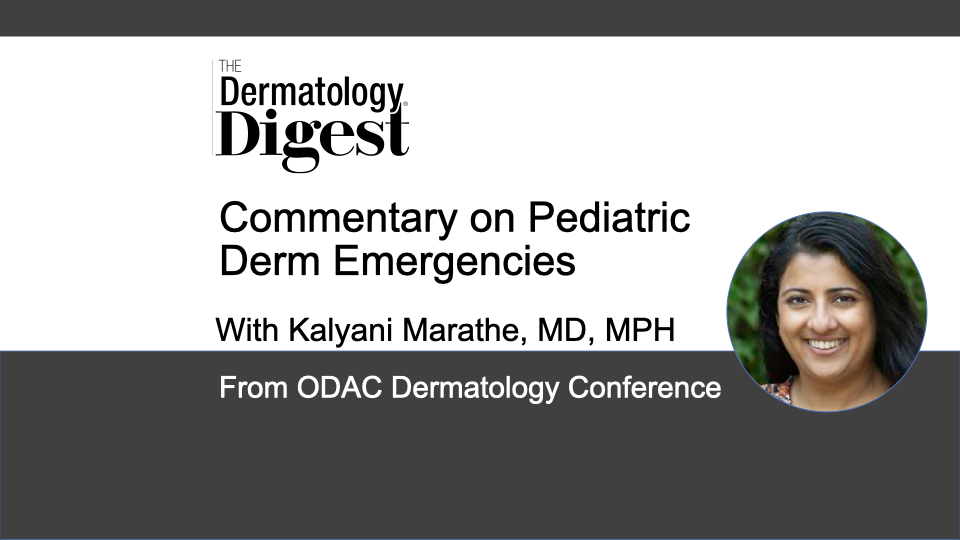Dr. Kalyani Marathe discusses diagnosing, differentiating, and treating various pediatric dermatologic emergencies.
Kalyani Marathe, MD, MPH, Director, Division of Dermatology and Associate Professor, University of Cincinnati, Department of Pediatrics
So when we think about… rashes that are caused by infectious agents, there’s a pretty broad range, but some of the newer things that we’re seeing [are conditions] like mycoplasma-induced rash and mucositis, or also called RIME, or recurrent infective mucocutaneous eruption,” said Kalyani Marathe, MD, MPH, who presented “Pediatric Derm Emergencies” at ODAC Dermatology Conference.
“And that is a basically an eruption that looks like Stevens-Johnson Syndrome but is caused by a viral or bacterial infection, most commonly mycoplasma. And this has probably been going on for many, many years, but we just recently…gave it a name and started identifying it.”
RIME is a common condition that has more mucous membrane involvement than skin involvement, said Dr. Marathe.
“So that can help us to determine if it’s that versus something else, like Stevens Johnson Syndrome.”
According to Dr. Marathe, the emergency room and primary care often cannot differentiate between erythema multiforme and urticaria multiforme, or “giant hives.”
“[Urticaria multiforme] is triggered usually by amoxicillin whereas erythema multiforme is usually triggered by a viral infection such as herpes simplex virus.”
Stevens-Johnson Syndrome and toxic epidermal necrolysis (TEN) is severe and should always be on your radar, said Dr. Marathe.
“That is where you get mucous membrane involvement; you get blisters. And that can have a lot of morbidity and mortality, so that’s something you want to identify really early.”
Those patients are often on antiseizure medication or antibiotics, said Dr. Marathe.
“And so looking through their medication history really closely can give you a good idea if that’s what’s happening.”
Drug hypersensitivity syndrome is also common, which children can get from various medications, often antibiotics, she said.
“It looks like a morbilliform drug eruption, but the patients are also more acutely ill and they [can] have liver involvement with liver inflammation as well as sometimes cardiac inflammation, and so they can be very acutely sick… that’s something that we want to identify early, if possible, because they might need systemic treatment if they’re going into the liver failure direction.”
Urticaria multiforme appears as giant hives and is often triggered by amoxicillin about 5 to 7 days after treatment. It looks scary and is very itchy but not dangerous, said Dr. Marathe.
“It is a real drug allergy so the baby can’t have that medication again but isn’t really something that’s very dangerous.”
A course of steroids may be necessary if joint swelling is affecting the child’s ability to walk, said Dr. Marathe.
“That can really help just cool them off within 24 hours. But, otherwise, [prescribe] antihistamines around the clock.”
Another condition to be aware of is tinea capitis because it is very common and often missed, said Dr. Marathe.
“It can be very mild, from just a few flakes of scale all the way to big patches of hair loss and juicy, boggy plaques that are studded with pustules and really goopy. So it can be very polymorphous and depends on the patient.”
According to Dr. Marathe, tinea capitis is more common in some kids than others.
“We do not know why, but it is much more common African American kids versus Caucasian kids, although we do see it in Caucasian kids too on occasion.”
Inflammatory types of tinea capitis can come from animal exposure, so ask about pets, advised Dr. Marathe.
“I’ve seen it come from all different kinds of pets, including a hedgehog most recently. Guinea pigs are another really common one and then, of course, cats and dogs. So always ask about [pets].”
Finally, if a school-aged child has scale in the scalp, feel the back of the scalp all the way up for occipital lymphadenopathy, she said.
“This takes some practice… but you can feel lymph nodes if you’re really thorough, all the way up, like, almost halfway up the back of the scalp.”
Mobile occipital lymph nodes almost always suggest tinea capitis, said Dr. Marathe.
“That’s tinea capitis to me until proven otherwise. Then we do a fungal culture in the clinic, but if I’m really suspicious, I just treat them. And I usually give them terbinafine for about eight weeks, and I make sure they take it for the full 8 weeks.”
Terbinafine is best administered crushed and mixed with food or with Hershey’s chocolate syrup, she said.
“…that hides the taste of everything. This is stuff that I learned from my nurses, and it really helps it go down more easily. So that is what I usually recommend.”
Also ensure that patients aren’t sharing combs or hats and are washing their sheets and towels in really hot water, said Dr. Marathe.
“Those are other things to keep them from reinfecting themselves.”


